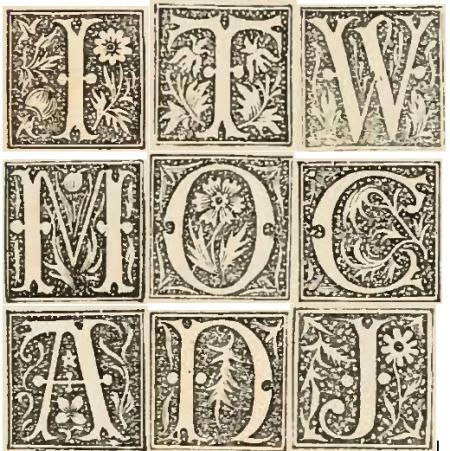What are these old caps?
These caps come from an 1869 reprint of The Celebrated Jumping Frog of Calaveras County by Mark Twain. They appear to be about 24pt. (blown up to see the detail). Now I’m not above recreating them digitally and having cuts made, but I hate duplicating effort.
Does anyone recognize these initial caps? If so, does anyone have a set they might either part with or can perhaps provide me a good proof to work from?

JumpingFrogCaps.jpg
Most likely European, definitely 19th century (or earlier????). What size are these?
Rick
Those are wonderful! I’d love to know what they are as well. Barring that, I’d be quite grateful if you’d be willing to share them with us if you do decide to scan them. Thanks for showing what you have so far!
They look to me to be contemporary wood-engraved initials, probably done locally for the publisher. They seem rather amateurish in design and execution. Curious as to who the publisher was, and their location? It could reveal more than just the images of the initials.
Paul
The publisher, C.H. Webb, does not appear to have published anything else of note. Only one other title besides The Jumping Frog appears on Abebooks.com. The printer, listed as John A. Gray & Green, was better known, and happens to be a shop in New York City where Samuel Clemens set type as a young man at a time when he later claimed he was working Mississippi riverboats. I could find no mention of them after about 1870. I suspect Paul may be correct about these being in-house.
I have only ever seen the book in .pdf format, and am guessing at a 24-36 pt. size. Since the initial caps are often repeated, these are the only examples of the face that I have, though for a reproduction of The Jumping Frog, they are truly all I need. If they’re not available in lead, I better get to work.
I guess I blew past the fact that the original querry stated that these caps are all 24 pt. I would think at that size they would be metal and not engraved wood. I have seen a set of old 19th century initials from Caslon that have this general feel to them, but they are not anywhere near the same. They do however have much the same sort of background detail.
Rick
24pt initials are not too small for a wood engraver. I have engraved extra letters for metal fonts that size. The above initials have a certain crudeness to their engraving that I would think they were originally made in wood. They probably were electrotyped and then beaten to snot, but I still think they were wood engravings originally.
Paul